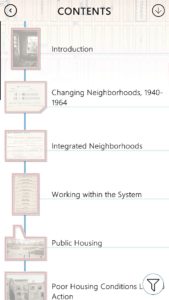A history of social movements, mapped in Philadelphia’s City Archives
 December 10, 2018
Category: Featured, Medium, Purpose
December 10, 2018
Category: Featured, Medium, Purpose
In the lobby of the newly moved City Archives, visitors meet “Charting a Path to Resistance,” an interactive mural based on a 1943 redlining map.
The mural, created by artist Talia Greene, chronicles the history of social movements in the city.
It’s appropriate for a building with 4,830 square feet of storage space for documents — including minutes of City Council meetings, property records and birth and death certificates — that tell the stories of Philadelphia’s past and present. The timeline of the collection begins in 1701 with the original City Charter written by William Penn, and ranges to present day, with sketches of the statue erected at the foot of City Hall in 2017 to memorialize civil rights activist Octavius Catto.
On Thursday, the City Archives celebrated its newly opened facility at 548 Spring Garden St. with a ribbon-cutting ceremony. It took two years to move millions of materials from the archive’s previous location on 31st and Market streets.
Greene said creating art for the facility appealed to her because of the project’s inherent focus on history. After seeing the redlining map while touring the facility, she knew it would be the blueprint for her mural, which highlights housing discrimination and abolition in the city.
“All of the stories are intended to be stories of resistance,” Greene told Generocity at the event. “The idea that they’re all these individuals throughout history who have been working in their small ways to counter resistance and oppression, I hope that will be inspiring.”
Records Commissioner James Leonard said Philadelphia is one of the few cities to still own a redlining map, which details where people of color lived so lenders could deny loans from applicants of those neighborhoods and other discriminatory real estate practices.
Portions of the mural outlined in red can be scanned by an app (named Resistance: Philadelphia) that will load supplemental information and digital copies of the archives. For example, visitors can scan the death certificate of Catto, who was murdered on South Street in 1871.
The mural is a product of the city’s Percent for Art Program, which requires developers to commission public art for projects worth $1 million or more. Philadelphia pioneered the initiative in 1959 as a leader in cities’ support of public art.
The project’s intent is “to have the artists speak to the very specifics of this particular place, this location, what it’s about … and to really bring out something that will encourage conversation, exploration and inquiry,” said Margot Berg, the public art director in the city’s Office of Arts, Culture and the Creative Economy.
Leonard said Greene’s mural shows what impactful stories can be told by the City Archives. Up to 3,000 people visit them annually, but all 1.5 million residents in Philadelphia can learn more about the history of their property, family and neighbors via the facility’s public research room.
“Some people might think, ‘What are archives? Are they sort of just a lot of old records, dusty books?’” Leonard said. “You’ll see, that is what the archives is. … But what’s contained in those, what we’ve discovered with Talia’s assistance … is that they bring out the stories that are contained in all of those records.”
Project
Office of Arts, Culture and the Creative EconomyTrending News










